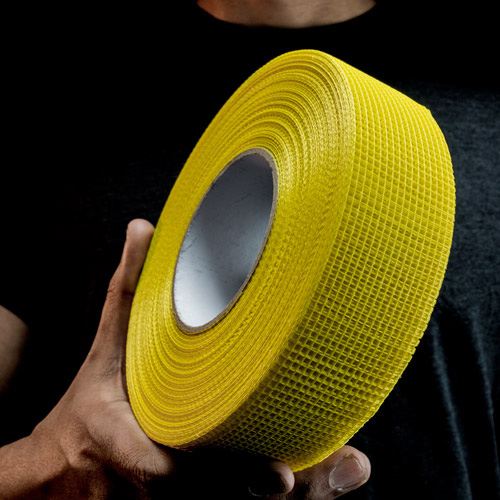- Products
- About Us
- Resources
- Contact UsCUSTOMER SUPPORT HOURSMONDAY-FRIDAY 7:30 AM - 5:30 PM CSTPHONE NUMBERSTAY CONNECTED
Patch Pro is a mesh drywall tape, ideal for seaming drywall joints and masking stucco applications. This self-adhesive fiberglass tape makes seaming and patching drywall faster and easier than paper drywall tape by eliminating the need to mud when combined with a setting compound. It’s breathable open weave construction allows moisture to evaporate for quick drying time compared to paper tapes, which helps Patch Pro lay flat without the risk of bubbles.
Patch Pro can also be used for drywall repair projects like cracks, plasterboard cracks and cement board. This drywall tape is available in sizes ranging from 2″ to 36″ wide. For more options, visit Surface Shields full line of adhesive tapes.
Let us find you a distributor or request a quote and we’ll provide pricing options right away. Surface Shields only sells through distribution.

| Available Colors | Blue , White , Yellow |
|---|---|
| Recyclable | No |
| Reusable | No |
| Breathable | Yes |
| Adhesive | Yes |
| Liquid Resistant | No |
| Flame Retardant | No |
What is mesh tape and how do you tape and mud drywall seams with it?
Mesh tape is an adhesive material used for jointing and reinforcing drywall. It can be applied to flat or corner joints, seams, and corners of the wallboard to create a stronger bond between the pieces. Mesh tape also helps prevent cracks from forming in the drywall by stabilizing it as it dries. To use mesh tape, cut the desired length, remove the backing paper, and press it firmly onto the joint. Cover with a thin layer of drywall mud and allow to dry before sanding or painting. Mesh tape is also great for use as a patch when repairing holes or cracks in drywall, allowing for a strong bond that won’t crack over time.
How to use drywall mesh tape
Taping and mudding drywall with mesh tape is a simple process. Start by cutting the desired length of mesh tape and removing the backing paper. Press the tape firmly onto the joint or seam, and press out any air bubbles along the way. Apply a thin layer of drywall mud over the mesh tape and allow it to dry completely before sanding or painting. Make sure to keep the mud layer thin, as too much drywall mud can cause cracking and bubbling in the finished product. For corners, use a corner trowel to apply the mud and create a smooth transition between the two pieces of drywall. Once dry, sand and paint as desired.
When to use drywall mesh tape?
Drywall tape is ideal for seaming and patching drywall areas that need additional reinforcement.
How to tape drywall joints?
Taping drywall joints involves applying a thin layer of joint compound and then pressing the tape into place. Start by cutting strips of paper joint tape to match the length of the seam or joint. Peel off the backing, then press the tape firmly into place. Smooth out any bubbles with your finger or a putty knife. Next, apply a thin layer of joint compound over the tape with a trowel or putty knife. Allow this to dry before sanding and applying additional layers. Finally, prime and paint as desired.
What is the difference in mesh tape and paper tape?
Mesh tape typically has an adhesive backing, making installation quick and easy. Paper tape must be embedded in a layer of joint compound.
Can you put paper tape over mesh tape?
Yes, you can put paper tape over mesh tape. However, it is not recommended as it is harder to work with and may increase the chance of cracking in the finished product. If you want to use paper tape, it should be applied before applying mesh tape. This will help ensure a strong bond between the two pieces of drywall and prevent any cracking that could occur with paper tape alone.
How to tape a drywall patch?
Taping a drywall patch involves applying drywall tape and joint compound to the patch’s edges. First, apply self-adhesive mesh tape along all seams and joints between the patch and the existing wall. Then fill in any gaps or cracks with an appropriate joint compound. Cover the entire area with a second layer of joint compound to seal it. Finally, use a drywall trowel to scrape away excess compound and smooth the area. Allow the patch to dry before priming and painting as desired.
